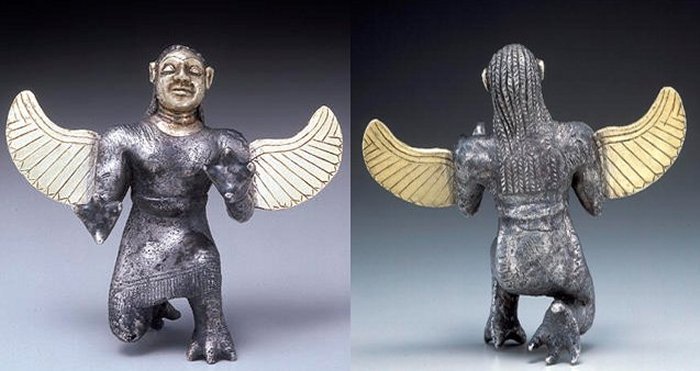Conny Waters - AncientPages.com - This unusual figure is unique in many ways. It represents a winged half-human and half-animal creature credited with supernatural powers. It is made of silver and electrum and dates back to the latter half of the 3rd millennium B.C.
Unusual winged half-human and half-animal creature. Image credit: Miho Museum
The figure is about 12 cm high up to the top of the head.
As you can see, this being squats with his left knee up, directs his face slightly upward, and extends his arms forward. A pair of large electrum wings with engraved sword-shaped feathers emerge from each side of his upper arms. Each limb has four talons at its end.
The figure's hair is shown in tufts with a herringbone-like pattern over its back. A thin electrum sheet covers the face, with the forehead and ears.
The small electrum figure sits straight, with firmly folded hind limbs, with both legs shown to the right and left. Each limb has a hoof of the ungulate type at its end. The figure's right arm is held up with the hoof's bottom directed forward, while its left arm is held with the bottom of the hoof directed toward the abdomen.
The head has two three-forked ox-like horns, and slightly wavy hair is parted in the middle and hangs over the back.
Winged bull with human head-AO 19859. Unknown author. Louvre Museum - Image credit: 0x010C -CC BY-SA 4.0
Based on current archaeological discoveries, no similar example of this horn type is known yet. It shouldn't be dismissed that a threefold horn or horn tassel may have been intended.
There are, however, examples of similar statues representing the Mesopotamian style in southern Iran. One of them is a small copper figure of the 3rd millennium B.C., which derives from Elam.
The creature is slightly similar to the lamassu, an Assyrian protective deity, often depicted as having a human's head, a body of an ox or a lion, and bird's wings.
The squatting or straight posture in figures wearing large girdles and kilts is found mainly in southeastern Iran's cylinder seals and stone vessels. It is not unusual to encounter representation of the hair in the silver figure of Eastern Iranian art. Half-naked figures are also commonly seen in ancient West Asian art.
Written by Conny Waters – AncientPages.com Staff Writer
Updated on April 20, 2023
Copyright © AncientPages.com All rights reserved. This material may not be published, broadcast, rewritten or redistributed in whole or part without the express written permission of AncientPages.com








